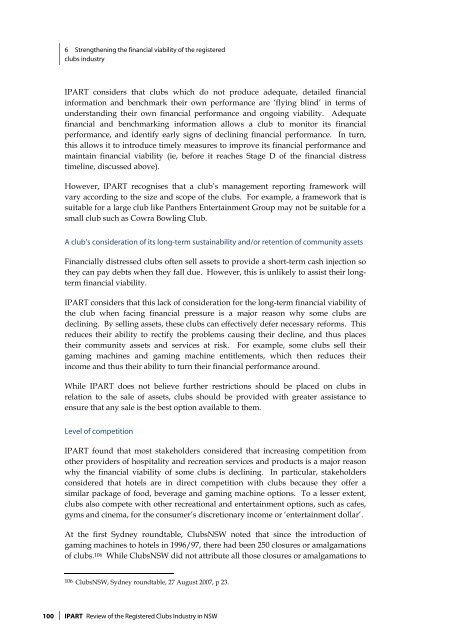Review of the Registered Clubs Industry in NSW - Clubs NSW
Review of the Registered Clubs Industry in NSW - Clubs NSW
Review of the Registered Clubs Industry in NSW - Clubs NSW
Create successful ePaper yourself
Turn your PDF publications into a flip-book with our unique Google optimized e-Paper software.
6 Streng<strong>the</strong>n<strong>in</strong>g <strong>the</strong> f<strong>in</strong>ancial viability <strong>of</strong> <strong>the</strong> registered<br />
clubs <strong>in</strong>dustry<br />
IPART considers that clubs which do not produce adequate, detailed f<strong>in</strong>ancial<br />
<strong>in</strong>formation and benchmark <strong>the</strong>ir own performance are ‘fly<strong>in</strong>g bl<strong>in</strong>d’ <strong>in</strong> terms <strong>of</strong><br />
understand<strong>in</strong>g <strong>the</strong>ir own f<strong>in</strong>ancial performance and ongo<strong>in</strong>g viability. Adequate<br />
f<strong>in</strong>ancial and benchmark<strong>in</strong>g <strong>in</strong>formation allows a club to monitor its f<strong>in</strong>ancial<br />
performance, and identify early signs <strong>of</strong> decl<strong>in</strong><strong>in</strong>g f<strong>in</strong>ancial performance. In turn,<br />
this allows it to <strong>in</strong>troduce timely measures to improve its f<strong>in</strong>ancial performance and<br />
ma<strong>in</strong>ta<strong>in</strong> f<strong>in</strong>ancial viability (ie, before it reaches Stage D <strong>of</strong> <strong>the</strong> f<strong>in</strong>ancial distress<br />
timel<strong>in</strong>e, discussed above).<br />
However, IPART recognises that a club’s management report<strong>in</strong>g framework will<br />
vary accord<strong>in</strong>g to <strong>the</strong> size and scope <strong>of</strong> <strong>the</strong> clubs. For example, a framework that is<br />
suitable for a large club like Pan<strong>the</strong>rs Enterta<strong>in</strong>ment Group may not be suitable for a<br />
small club such as Cowra Bowl<strong>in</strong>g Club.<br />
A club’s consideration <strong>of</strong> its long-term susta<strong>in</strong>ability and/or retention <strong>of</strong> community assets<br />
F<strong>in</strong>ancially distressed clubs <strong>of</strong>ten sell assets to provide a short-term cash <strong>in</strong>jection so<br />
<strong>the</strong>y can pay debts when <strong>the</strong>y fall due. However, this is unlikely to assist <strong>the</strong>ir longterm<br />
f<strong>in</strong>ancial viability.<br />
IPART considers that this lack <strong>of</strong> consideration for <strong>the</strong> long-term f<strong>in</strong>ancial viability <strong>of</strong><br />
<strong>the</strong> club when fac<strong>in</strong>g f<strong>in</strong>ancial pressure is a major reason why some clubs are<br />
decl<strong>in</strong><strong>in</strong>g. By sell<strong>in</strong>g assets, <strong>the</strong>se clubs can effectively defer necessary reforms. This<br />
reduces <strong>the</strong>ir ability to rectify <strong>the</strong> problems caus<strong>in</strong>g <strong>the</strong>ir decl<strong>in</strong>e, and thus places<br />
<strong>the</strong>ir community assets and services at risk. For example, some clubs sell <strong>the</strong>ir<br />
gam<strong>in</strong>g mach<strong>in</strong>es and gam<strong>in</strong>g mach<strong>in</strong>e entitlements, which <strong>the</strong>n reduces <strong>the</strong>ir<br />
<strong>in</strong>come and thus <strong>the</strong>ir ability to turn <strong>the</strong>ir f<strong>in</strong>ancial performance around.<br />
While IPART does not believe fur<strong>the</strong>r restrictions should be placed on clubs <strong>in</strong><br />
relation to <strong>the</strong> sale <strong>of</strong> assets, clubs should be provided with greater assistance to<br />
ensure that any sale is <strong>the</strong> best option available to <strong>the</strong>m.<br />
Level <strong>of</strong> competition<br />
IPART found that most stakeholders considered that <strong>in</strong>creas<strong>in</strong>g competition from<br />
o<strong>the</strong>r providers <strong>of</strong> hospitality and recreation services and products is a major reason<br />
why <strong>the</strong> f<strong>in</strong>ancial viability <strong>of</strong> some clubs is decl<strong>in</strong><strong>in</strong>g. In particular, stakeholders<br />
considered that hotels are <strong>in</strong> direct competition with clubs because <strong>the</strong>y <strong>of</strong>fer a<br />
similar package <strong>of</strong> food, beverage and gam<strong>in</strong>g mach<strong>in</strong>e options. To a lesser extent,<br />
clubs also compete with o<strong>the</strong>r recreational and enterta<strong>in</strong>ment options, such as cafes,<br />
gyms and c<strong>in</strong>ema, for <strong>the</strong> consumer’s discretionary <strong>in</strong>come or ‘enterta<strong>in</strong>ment dollar’.<br />
At <strong>the</strong> first Sydney roundtable, <strong>Clubs</strong><strong>NSW</strong> noted that s<strong>in</strong>ce <strong>the</strong> <strong>in</strong>troduction <strong>of</strong><br />
gam<strong>in</strong>g mach<strong>in</strong>es to hotels <strong>in</strong> 1996/97, <strong>the</strong>re had been 250 closures or amalgamations<br />
<strong>of</strong> clubs. 106 While <strong>Clubs</strong><strong>NSW</strong> did not attribute all those closures or amalgamations to<br />
106 <strong>Clubs</strong><strong>NSW</strong>, Sydney roundtable, 27 August 2007, p 23.<br />
100 IPART <strong>Review</strong> <strong>of</strong> <strong>the</strong> <strong>Registered</strong> <strong>Clubs</strong> <strong>Industry</strong> <strong>in</strong> <strong>NSW</strong>
















